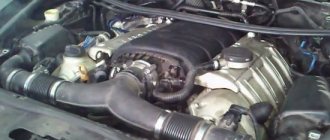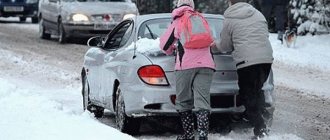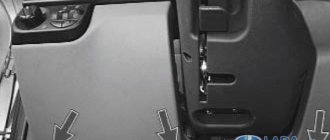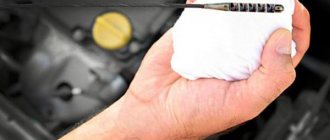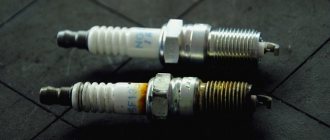If the car seizes, but the engine does not start
If it is not possible to carry out repairs at a car repair shop, then you will have to fix everything yourself. This does not require any special skills. First of all, you need to clean the contact points of the battery. Also check the car's spark plugs and clean them of dirt. Poor and dirty starter contacts can also cause engine failure. The best way to find a problem is by elimination.
The fuel supply system also plays a significant role in the operation of the vehicle. If the starter is working well, at the moment of engine failure, we check it. It consists of a carburetor, a special pump and an injector. It is best to start checking with the pump. On some cars it may be electric. When you turn on the ignition, you should hear the sound of a running motor; if you can’t hear it, then it could burn out. Also, lack of voltage can stop it from working. In this case, it is necessary to check the fuses.
On carburetor cars, on the contrary, it is necessary to check the mechanical pump. You can find out about its working condition using the hose from the outlet fitting of the pump or carburetor. Using a special handle, look at the condition. If gasoline begins to splash out of the pump, then the entire system is working properly.
On injection cars we carry out a similar procedure. The only difference is the location of the fitting. As soon as the valve is pressed, gasoline will spray out of the hose. The fuel must be under high pressure in the fuel pump. In this case, you can judge the good technical condition.
If after these procedures the engine also does not start, then it is best to go to a specialist. In auto repair shops it is necessary to carry out a complete diagnosis of the carburetor of the vehicle. It is virtually impossible to do such a procedure on your own. It is performed using special equipment. Replacement and diagnostics are quite an expensive process, so you need to choose a good workshop. Many experts note that in order to eliminate such breakdowns, it is necessary to regularly carry out an initial technical inspection of the machine.
What should you do if your car stalls on the road and won’t start?
First of all, you need to try to find the reason why the engine stalled on the road, when the reason is known, you can try to fix it, then the engine will start. But don’t think that the engine can be affected by dirty headlights or a loose wheel, so we won’t consider the story about unworn headlights.
It is also very important to take into account the operation of the engine before it stalled; if it worked well and stalled abruptly, these are some reasons, and if it started to work intermittently, it loses traction, these are other reasons. Let's try to figure this out now. But it is not always possible to repair the engine on the road, since the necessary part may not be at hand.
I will not focus on a specific brand of car, all internal combustion engines work on the same principle, so identifying the cause and eliminating it will work for any brand of car.
I will describe simple solutions to the problem on the road, which are accessible to people who are not very knowledgeable about the car, since the masters do not need this; they themselves know what to do. Knowing these methods, even a person who does not understand the car will be able to fix a minor engine breakdown and move on. But if the breakdown is serious, even the repairman is powerless, since spare parts are needed.
Gasoline is not supplied
Let's move on to the second group of faults: the starter turns, but the engine does not start. It’s unlikely that you didn’t notice the light on, signaling a low fuel level - and there is simply no gasoline in the tank. Most likely, there is enough gasoline, but there is a malfunction in the power system.
Therefore, let's start with the simplest diagnostics - if after turning the ignition key you do not hear a buzzing sound, then the fuel pump does not turn on. Sometimes this happens due to oxidation of the electric motor commutator after a long period of inactivity. Or there is no power supplied to it, because it is often this circuit that alarm installers cut into. Another probable reason, which occurs exclusively in winter, why fuel is not supplied to the engine, is that the water that has entered the tank has frozen and blocked the path of the “fuel”.
The starter turns, but the engine does not start. 10 reasons
Every car owner may face the fact that one day his car will refuse to start. There can be quite a few reasons. We tried to narrow the topic and assume that you know for sure that the starter turns
and responds to the turn of the key.
1. The most banal reason
- lack of fuel. If there is no gasoline, then it is useless to start the car.
2. The funniest reason
— the exhaust pipe is tightly closed with a potato, banana, snow or rag.
3. Your carelessness
— you forgot to turn off the alarm, which blocks the fuel supply to the injector.
4. The most criminal option
— they tried to steal your car, but something went wrong.
5. The coldest reason
— the water in the fuel line, filter, gas tank is frozen.
6. Oil is out of season
, or very cold. In this case, the starter will turn, but not as fast as it should.
7. Fuel pump malfunction
. First of all, we check the fuse; if they are working, and there is no characteristic buzzing after turning the ignition key, then most likely the electric pump has burned out.
8. Malfunction of the ignition system.
In the circuit - a coil, high-voltage wires, candles - no electricity passes through. Tester to help.
9. Timing belt malfunction.
The belt broke or jumped several teeth, which resulted in a violation of the valve timing. In this case, it is better not to turn it at all, so as not to damage the valves and pistons of the engine.
10. The most destructive reason
. The connection between the starter gear and the flywheel ring teeth does not engage. Either the ring is damaged (it may simply be slipping) or the starter. In any case, when cranking the starter there will be a ringing or crunching metallic sound.
Source
Problems with the fuel system
Even the most “vigorous” battery and a new, working starter will not be able to start the car if problems arise with the supply of fuel to the cylinders. For this reason, the next thing to check is the engine power supply system.
Fuel pump
For carburetor and diesel engines, this unit is located directly next to the cylinder head or block. Injection power plants are equipped with an electric pump, which is installed in the fuel tank. Their operation is judged by a short buzzing sound that appears after the ignition is turned on. As for fuel pumps in carburetor engines, they are mechanically driven by a cam mounted on the camshaft.
It is easy to check the functionality of the fuel pump - to do this, remove the hose from the carburetor inlet fitting and lower it into a suitable container. After this, you should pump up the fuel using the manual pumping lever or by turning on the starter. If the result is negative, check the passage of gasoline through the fuel line and clean the mesh located in the top cover of the pump. If this does not help, then inspect the membrane and valves of the fuel pump. After replacing damaged and worn parts, the functionality of the device will be restored.
Symptoms of a clogged fuel filter:
- significant excess fuel consumption;
- the engine does not start well;
- its power decreases - there is no traction, the car accelerates poorly (especially when driving uphill);
- sharp acceleration threatens to turn into a stalled engine;
- at idle speed there is uneven operation of the engine;
- Spontaneous braking of the car may occur without driver intervention.
Starter problems
The starter often fails in cars of any manufacture. He does not have enough strength to spin, and therefore to put the engine into operation. To solve this problem, you need to know all the vulnerabilities of this machine part. The driver needs to check the functionality. The starter on foreign cars is more demanding than on domestic cars.
To troubleshoot, it is recommended to remove it from the car and completely clean the body and fastening elements. Old grease must be carefully removed from the part. This is quite simple to do, but you shouldn’t abuse it. You can check the starter for noise level. If you hear a clicking sound when you try to ignite and it does not turn, then the reason is the relay. Therefore, here you only have to change or repair it. But it should be remembered that the relay is repaired if it is disassembled into its component parts.
The starter is acting up
The most common causes of failure: oxidized and burnt contacts, traction relay frozen due to moisture, wear of brushes and commutator. If the starter is accessible from above, you can simultaneously try to turn on the starter and tap the traction relay with a wrench or hammer (only lightly!). Or close the starter contacts directly. To do this, use a screwdriver to bridge the thick terminal to which the positive wire from the battery goes with a small terminal to which the thin wire goes. If the starter starts to rotate, the starter control circuits (usually the ignition switch) are faulty or are blocked by a faulty alarm system.
If the car has a manual transmission, you can push the engine and drive to the service under your own power. If you have an automatic, look for a tow if the service is close, or call a tow truck.
Starter and ignition switch
You can diagnose the correct operation of the ignition switch in the following way: the key in the ignition switch is turned to the second position. A failure of the ignition switch will be indicated by lights on the control panel that do not light up.
But you can use one more method to check - if the headlights that are turned on when starting the engine begin to dim, this is evidence that the ignition is working properly. If this node turns out to be faulty, the problem can be solved by replacing the switch.
The starter can be seriously damaged by dirt accumulating on it.
You can check it only if you have a tester, and for this you will definitely need a partner. So, the tester should be connected to the starter power wire. At this time, your partner should try to start the engine. If the tester readings indicate the presence of electric current in the circuit, but the starter does not crank, then in this case the starter will definitely have to be replaced.
Attention! During the procedure, try not to touch the exposed wiring with your hands - be sure to use insulating gloves!
What to do if the voltage does not reach the starter
If the headlights continue to burn brightly when you try to start the engine and nothing happens (the starter does not turn), then the voltage is not reaching the starter. This could be due to an open or poorly adjusted emergency park/neutral switch, damaged ignition switch, or faulty starter relay (solenoid). Fuses and fuses are also worth checking, as they could have burned out from overload caused by constant cranking or starting from an external source (“lighting up”).
If the starter clicks when you try to start the engine, but nothing else happens, there may not be enough current to turn the starter. Or maybe the starter has failed
The problem may be a bad battery cable, solenoid or ground, or high resistance of the solenoid itself. Check the voltage at the solenoid to see if battery voltage is passing through the ignition switch circuit. If the solenoid or relay is receiving battery voltage but is not closing its contacts or conducting enough electrical current to turn the starter motor, the solenoid ground may be damaged or the solenoid contacts may be worn, burnt, or corroded.
If the starter turns bypassing the solenoid, it means a new solenoid is needed, not a starter.
Most engines only start at 200 to 300 rpm, so if you have a weak starter that can't get the engine up to speed and provide compression, the engine won't start. In some cases, a weak starter will be able to spin the engine to the required speed, but the engine will still not start, since the starter will take all the battery charge and leave no energy for the injectors or ignition system.
Details on how to drive a manual
When, when trying to start the engine, the headlights dim and the crankshaft does not turn or turns weakly, this may be due to the fact that the starter is jammed, it is slipping or overcoming high internal resistance, its brushes are worn out, or there is a short circuit or break in the windings or armature. Measure the current draw of the starter to see if it is drawing too much current.
Battery low
This can happen in one frosty night if you forgot to turn off some consumer of electricity (for example, headlights), and the car does not have battery discharge protection. This happens even more often with cars that have non-standard powerful “music” or security alarms installed. Nowadays, many people work remotely and don’t go anywhere for weeks - during this time, the old battery can run out, even if there is no increased energy consumption.
Place the dead battery on charge. And if you need to go urgently, you can “light up” from the donor car (don’t forget to put jumper wires in the trunk in advance) or from a battery starting device (booster). If the car has a manual transmission, you can revive the engine by towing it or pushing it.
Circuit breakers
The reason that the engine does not start when the starter is working properly may be as follows: there is no electricity supplied to the spark plugs. By the way, they themselves cannot in any way serve as the cause of problems, if only because the likelihood of them all failing, and even at the same time, is small. Therefore, it may very well be that voltage is simply not supplied to the high-voltage wires connected to them. If the design of the ignition system of a particular engine is such that it is supplied through fuses, then first of all you need to check them.
Electronic engine control unit
All modern engines installed in passenger cars are equipped with electronic control units, which may also be the reason why, with a charged battery and a working starter, as well as a working ignition system, the engine may not start at all, or, once started, it stalls immediately.
This can happen, for example, when the ECM or DPKV sensors fail. The bottom line is that after starting the engine, they send its electronic control unit incorrect data about the composition of the fuel mixture and the position of the crankshaft. The ECU interprets them and issues completely different commands to the corresponding actuators. As a result, the engine, as soon as it starts, immediately stalls.
Another “electronic” reason that it is impossible to start the engine when the battery is full of energy and the starter is full of power is a malfunction in the car alarm. Almost all passenger cars are now equipped with it, and not all models of these devices are highly reliable. Quite often it happens that they are the ones who block the engine from starting, believing that they are trying to start it in an “unauthorized” way.
Throttle valve
As for possible malfunctions of the fuel system leading to the inability to start the engine, among them, as practice shows, problems with throttle valves lead by a wide margin. These design elements of modern internal combustion engines are nothing more than mechanical regulators of the flow area of the channel through which the fuel mixture ultimately enters the cylinders.
If the throttle valve does not work correctly for one reason or another, then it simply, in fact, cuts off the fuel supply. Since the cylinders are empty and there is nothing there to ignite, the engine does not start.
If the car is fuel injected...
The engine stalled, what to do if the car is fuel injected. For a car with a fuel injection system, after checking the spark plugs, you should check the fuses for integrity; you need to carry them with you, at least one at a time for different voltages. In such cars, electronics are responsible for a lot of things, and they are often to blame for problems. Then inspect all wires, terminals, contacts and the electronic control unit. It may need to be disassembled and wiped dry. Don't forget to disconnect the terminals from the battery before doing this. The terminals themselves need to be cleaned. If one injector fails, the engine continues to operate, but several injectors cannot fail at the same time.
This is interesting: Which shock absorbers are better to install on a VAZ 2107
Next, you need to correct the fuel component. You should start by checking the gasoline pressure. You need to press the spool, as a result a trickle of gasoline should appear. If it is not there, it is worth inspecting the fuel pump. The procedure must be carried out with a cold engine. Next, we check whether power is supplied to the fuel pump; if it is not, we supply it from the heated rear window. Try pouring a little fuel (about 10 ml) through the throttle valve slightly open into the intake manifold. Be careful when doing this; excess gasoline may melt the ceramic block.
If you don’t understand the workings of a car, a mobile phone and friends will help out
In general, various sensors are to blame for sudden checks of an injection car. One of them is the crankshaft position sensor; you need to have it in stock. If there is no idle speed of the engine, that is, the car stalls when you release the gas pedal, it means that the idle speed controller has failed. In an emergency, you can open the throttle slightly by pulling the drive cable. Another possible reason is a wet or clogged air filter; you should get rid of it in the same way as the fuel filter; the car will drive to the garage without it.
It is important to remember that the above recommendations will help those car enthusiasts who have an idea about the structure of the car. If the driver has a vague idea of where the fuse box is and what a carburetor is, then you should not interfere with the operation of what is under the hood. In the modern world, this is not required, because a mobile phone can always come to the rescue. It is not as important to have a spare part in stock as it is to be on call in an emergency. If you're not entirely sure which car parts to pack in your car, be sure to keep a charged phone with a positive balance in your pocket or purse. Good luck on the road!
Spark plug
The problem with starting the engine may be related to the spark plugs. Their performance is checked as follows: the spark plug is unscrewed, then connected to the high-voltage wiring and placed on one of the metal parts. At this time, the assistant turns the ignition key. The absence of a spark will indicate a faulty spark plug.
Attention! Before checking the spark plug, you should make sure that there are no flammable liquids near the test site. Do not touch the spark plug with your hands while turning the ignition key. The presence of a spark is determined only visually.
If it is not possible to reach the spark plugs, you can use an inductive tool to check them. When the magnetic field is detected by it, the indicator will light up - this will mean that the candle is fully operational. Otherwise, this component will have to be replaced.
There may be several reasons why a spark does not appear during diagnostics:
- the ignition module is faulty;
- the ignition coil is broken;
- The shaft position sensor is faulty.
To check the above sensors, electronic diagnostics are used by connecting the scanner to a special connector. It reads errors that occur when sensors are damaged. You can also use an ordinary voltmeter for this purpose. The resistance shown by it must comply with the standards established by the manufacturer, otherwise we can confidently assume the possibility of a sensor malfunction.
The spark is gone
The engine began to lose traction and stalled
There are usually only two reasons for this malfunction, the first is rain and puddles. Usually this is the case, in dry weather the engine runs well, but in the rain it starts to stall and flood the spark plugs. Most likely there is no engine protection at the bottom, water gets on the spark plugs, ignition wires, and floods the ignition coil. At this moment, the spark may go to ground, which causes poor ignition of the working mixture in the cylinders, unburned gasoline floods the spark plugs. Wipe the wires and everything listed above dry, drive slowly, especially through puddles, so that water does not flood the electrical equipment again.
This is interesting: What is needed to paint a car
Either drops of gasoline fly into the carburetor or injector air manifold through the breather hose, also causing spark plug failures, remove the breather from the filter and the path blows onto the street, hang up where the breather hose is attached, plug it with a plug or rag, the engine is fine, you can go.
Secondly, the carburetor begins to overflow gasoline; often this problem is caused by either a worn carburetor needle, or a speck has gotten under the needle, which leads to an overflow of gasoline. The injector, here is more complicated, cannot be repaired on the road, diagnostics are needed, which should reveal the reason for the strong enrichment of the working mixture; more often than not, the temperature sensor is to blame for this problem. It shows the computer that the engine is colder than it actually is, the computer gives a richer mixture, which leads to flooding of the spark plugs.
timing belt
Both a belt and a metal chain can be used as a timing drive. This mechanism is responsible for the rotation of the crankshaft and camshaft. After a certain time, the drive will definitely wear out - this applies to a greater extent to the belt drive, which may even break. Because of this, the valves become deformed, which is already a serious breakdown of the propulsion system and, of course, if such damage occurs, the car will not be able to start. To avoid this, it is necessary to replace the belt drive at least once after 60,000 km.
Belt broke
There are much fewer mechanical faults that prevent the engine from starting than electrical ones. The most likely is a broken timing belt. Due to increased loads when cranking a frozen engine, a worn drive most often breaks during startup. It happens that the crown on the flywheel turns. In this case, the starter cannot spin the engine to starting speed.
***
In general, modern cars are reliable. And most often the engine does not start because the battery is discharged or the contacts of the power wires have oxidized. But the above malfunctions are also not exotic. And when they arise, it is better to have at least a rough idea of what is wrong with the car. Then it will be easier to negotiate with the servicemen.
The car boiled, stalled and would not start
The car boiled, stalled and will not start. In this case, I sympathize, usually when the engine boiled but the driver turned it off in time, everything is fine with the engine. But if you noticed it too late, you turned it off, but then the engine wouldn’t start, or it started but it didn’t work well, it flooded the spark plugs, there’s one problem, the piston rings in the pistons are burnt, because of this, the compression has dropped significantly, the piston rings leak oil, the oil floods the spark plugs. The engine will have to be repaired, the piston group changed or bored for repair pistons.
Air filter
To start the engine properly, you need a lot of clean air. Its flow will be greatly hampered if the air filter is clogged. As a result, this leads to difficulty starting the engine due to the incorrect air mixture required to ignite the fuel. You need to check not only the filter itself, but also the air ducts - debris can also accumulate in them.
Filter connections can also leak.
For example, the engine may not start due to too much oxygen entering the system, which may well be caused by damage to the pipes.
By the way, visual inspection of pipes does not always give positive results - checking their tightness is much more effective by ear.
Low air temperature
If the air temperature drops to 15 degrees, then any battery loses up to 50% of its power. At the same time, it can be very difficult to start the car. To “wake up” the car, you should activate the high beams for a few minutes. As a result, the electrolyte will heat up, which will give it additional energy.
When trying to start the engine, do not turn the starter for more than 5 seconds, as in this case you can fill the spark plugs or completely discharge the battery. Do not forget that trying to start the engine in severe frost will be equivalent to driving 500 km.
Why doesn't my car start in winter?
The car and all its systems experience increased loads in winter:
- The battery is usually the first to suffer (quick discharge in the cold, the battery does not hold a charge);
- the load on the starter and generator increases noticeably, causing breakdowns;
- in conditions of high humidity, the car does not start due to oxidation of the contacts or as a result of water entering the engine compartment;
- when “cold”, worn out engines lose a lot of compression;
- in some cases, a significant change in the properties of the engine oil occurs (the lubricant becomes very thick);
For example, if the engine oil has thickened, it is more difficult for the starter to crank the crankshaft in such a viscous mass. Add to this the battery discharge, general engine wear and compression reduction, as well as not the best spark plugs and fuel. The result is that the engine starts normally in the summer, but completely refuses to start when cold weather arrives.
To avoid such problems or minimize them, it is better to fill in engine oil with “winter” viscosity (0W, 5W) in advance. It is also recommended to change all filters, change spark plugs and BB wires. As for the battery, you need to remove the battery, service and charge the battery with a charging external charger.
Problems starting a diesel engine
Starting problems occur in cars with both gasoline and diesel engines. At the same time, the diesel engine requires increased attention. Below we will consider what to do if the car does not start, but the engine itself is diesel.
When a diesel car does not start, not all car enthusiasts know what to do in this case. In diesel engines in winter:
- Diesel fuel often freezes;
- glow plugs fail;
- A well-charged battery is required;
The diesel fuel is frozen
In fact, diesel fuel freezes due to the “waxing” of such fuel in the cold.
If the starter turns, but the diesel engine does not start, you need to take the car to a warm box. In the event that the performance of the fuel system is impaired as a result of frozen fuel, the problem will be solved.
In cold weather, you should always use special winter diesel fuel (contains additives in diesel fuel that prevent the fuel from freezing).
Glow plugs
Glow plugs are also the reason why a diesel engine does not start in winter. Unlike gasoline engines, diesel glow plugs heat the combustion chamber before starting the engine so that the fuel is effectively ignited by compression.
We also recommend reading the article on how to flush the power system of a diesel engine. From this article you will learn about methods for flushing the fuel system of a diesel engine, as well as the subtleties and nuances that need to be taken into account when such flushing.
If such spark plugs do not work on a diesel engine, ignition does not occur. Glow plugs require regular inspection and replacement. At the same time, it is better to change them before the onset of cold weather; it is optimal to replace them as a set (all glow plugs are immediately replaced with new ones).
Diesel engine
A diesel engine differs from a gasoline engine primarily in its ignition. At the end of the compression stroke, the temperature of the air in the combustion chamber rises to over 700 °C. At this point, atomized fuel is injected, which ignites when in contact with hot air. Due to the high thermal conductivity of the cylinder head, some of the thermal energy produced by the compressed air is inevitably carried away through the cooling system - the lower the temperature of the cylinder head and coolant, the lower the temperature. Therefore, to prevent the temperature of the compressed air from falling below the temperature required to ignite the fuel, the air in the cylinders is additionally heated by spark plugs before starting a cold engine. This is especially necessary when it’s frosty outside.
If a diesel engine refuses to start when cold, first check the spark plugs. A cold diesel engine starts with a faulty glow plug, even if the starter has been running for a long time.
More often in this case, the starter turns the crank, but does not catch it. A cold diesel engine with damaged glow plugs does not start without problems at temperatures below + 5 ° C, and even more so at sub-zero temperatures. It may even seem that the starter is not responding well.
Check the glow plugs:
First make sure the glow plug driver is working correctly. To do this, connect the test lamp to the glow plug power bus and to ground and turn the ignition key to the “on” position; if the controller is working, the test light will light up. For further checks, turn off the ignition and disconnect the power bus from the glow plugs.
Methods for checking glow plugs:
- Connect a 21 W light bulb with one end to the positive terminal of the battery using a piece of thick wire, and the other to the candle terminal. If the lamp is half on or off, the spark plug is faulty.
- Unscrew the plugs and connect them to the battery with strips of thick wire; in turn, if the spark plug does not light up to the point of incandescence, it will be damaged.
If the starter cranks for a long time and the car does not start, it may also have a high pressure fuel pump (HPF) or a safety shut-off valve. With these malfunctions, the car will not start either in cold or warm weather.
Diagnostics can be run by checking the power supply to the muffler (it opens when power is turned on and closes when turned off). The easiest way to check the valve's power is to use a test lamp; be sure to turn on the ignition before checking. If the valve clamp is live, remove and replace the connector that connects it. The valve should make a clicking sound. If it does not click, we can assume that the valve is faulty.
Bleeding the fuel system:
A manual fuel priming pump will make emptying the system much easier.
Find the place in the fuel line where the air will come out - unscrew either the plug in its upper part or the return nozzles. If the fuel filter has a hand pump, turn the ignition on to open the muffler and pump fuel until no more air comes out from the selected point and no more fuel comes out. If the car does not have a manual prime button and a low pressure pump, the pressure is electrically actuated, simply turn the ignition on for a while after clearing the air path from the fuel pump. If pumping fails, check the fuel filter; perhaps it is simply clogged with dirt or paraffin.
Computer diagnostics
If a motor with a working starter does not start, pay attention to the dashboard indicators. When you turn the ignition key, the CHECK, battery, and oil pressure sensor malfunction indicators should light up, and the immobilizer indication should stop. In cars with an injector, after turning the key, you should hear the characteristic sound of the fuel pump pumping - a soft buzzing sound.
If the car does not start with the starter working normally and the tachometer needle does not move, although the electric motor cranks the engine, you need to check the crankshaft sensor. If this element fails, the engine will not be able to start, since permission to do so is not given by the electronic control unit.
To obtain complete information, diagnostic equipment is connected through a special connector, in which the car model and engine type are selected. After connecting to the car’s ECU, the laptop screen will display error codes that are currently relevant. If necessary, you can open a diagram of the car where the area with the breakdown will be localized.
When the starter is working properly, it is necessary to remove several parameters, the failure of which can lead to breakdown:
- The vacuum gauge should show a pressure equal to atmospheric pressure, about 1 bar.
- The specified idle speed must correspond to the characteristics of the engine.
- The engine temperature during cold start should be equal to the ambient temperature.
To track the operating mode of the motor, it is necessary to track its revolutions in real time when the starter rotates, for which there is a special tab in the software. To do this, the starter is started and the crankshaft speed per minute that it provides appears on the screen. The norm is a little more than 200 rpm. If the data remains at zero, the problem is in the crankshaft sensor, which needs to be replaced.
What to do if your car stalls
Almost every driver, at least once in his life, has encountered some kind of breakdown of his car. It is especially unpleasant when the car stalls, and this happens while driving. Firstly, the car is clearly not in a garage, where it is easier to find the causes of this trouble, and secondly, this can lead to a traffic accident.
You can try to solve the minimal causes of the malfunction by trying to turn on the ignition (starter) again, but what to do if the car stalls and does not start? In such a situation, there are general recommendations that can identify the reasons why the car stalled while driving.
These Common Reasons Your Engine Won't Start Will Surprise You
There's nothing worse in the morning than when your car refuses to start. Here are possible reasons for this and tips for determining the cause of the problem, as well as ways to solve it.
There is no fuel in the car
This is the most common problem faced by millions of car enthusiasts. The fuel level is the first thing you should check, no matter how funny it may sound. After all, you may well not have noticed that the car’s fuel level is at zero. Yes, it may look stupid, but believe me, very often this is the reason the engine fails to start. So if this happens to you, go to the gas station. Here is a simple solution to the problem.
The clamps of the high-voltage wires are loose
The second most common reason for the engine not starting is poor contacts of high-voltage wires with the battery terminals. This occurs due to the fact that the clamps of the high-voltage wires have become loose. So if your car won't start, open the hood and check the tightness of the terminals and their condition. If there is oxidation on them, clean the terminals and then try turning the ignition on again. By the way, the first sign that the terminals have poor contact due to poor tightening is oxidation on them.
Sources
- https://AvtoSotka.ru/tyuning-i-remont/starter-ne-zavodit-mashinu.html
- https://www.zr.ru/content/articles/926421-pochemu-motor-ne-zavoditsya.-sem/
- https://topgears.com.ua/stati/sovetyi/pochemu-ne-zavoditsya-mashina-prichinyi
- https://fastmb.ru/soveti_auto/2919-pochemu-ne-zavoditsya-avtomobil-glavnye-prichiny.html
- https://AvtoNov.com/%D0%BF%D0%BE%D1%87%D0%B5%D0%BC%D1%83-%D0%BD%D0%B5-%D0%B7%D0%B0 %D0%B2%D0%BE%D0%B4%D0%B8%D1%82%D1%81%D1%8F-%D0%BC%D0%B0%D1%88%D0%B8%D0%BD% D0%B0/
- https://KrutiMotor.ru/ne-zavoditsya-mashina-prichiny/
- https://topmekhanik.ru/chto-delat-esli-ne-zapuskaetsya-motor/
- https://1gai.ru/publ/522183-15-prichin-po-kotorym-vash-avtomobil-ne-zavoditsya.html
